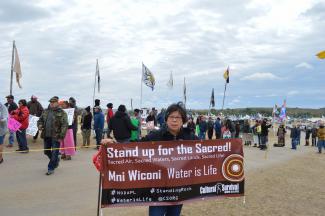
On August 5, 2015, the Gold King mine spill sent 3 million gallons of mine wastewater and tailings into the Animas River, impacting waterways of the Navajo Nation as well as municipalities in Colorado, New Mexico, and Utah. That day I was participating in the 2015 Food Sovereignty Conference hosted by the Shiprock Chapter and the International Indian Treaty Council in my home community of Shiprock, New Mexico, where discussions of food sovereignty, pollution, loss of traditional knowledge, and dispossession of traditional lands were taking place among local farmers, community members, and participants from neighboring tribes. The plume of deeply yellow colored water reached the community of Shiprock midday. The irony of discussing growing food and food sovereignty with the sobering reality of the contaminated water, land, and polluted skies was nothing short of tragic and reaffirmed the urgency of protecting our life sustaining resources.
Today, the health of the Navajo people in Shiprock is at a higher risk than ever before due to loss of farming livelihoods and the long term impacts of contamination. There is no compromise in making this situation tenable. As Navajo people, our human rights are again violated. This story goes beyond Shiprock, beyond the United States, beyond North America. At the heart of it is a story of conquest, colonization, environmental destruction, corporate greed, and forgotten peoples that resonates around the world with many Indigenous Peoples. It is also story of survival, spiritual strength, and cultural integrity.
Each of the stories told in this issue of the CSQ represent calls to action to protect our lands and territories, to sustain life, and to stand up in resistance. The Declaration of the Indigenous Food Sovereignty and Traditional Knowledge for Climate Change Resiliency Gathering is a word prayer honoring our relationship to Mother Earth and reminds us of our gifts, strengths, responsibilities to life, and the resiliency given to us through our spiritual understandings to endure and walk the path of honoring all living things.
At Standing Rock, North Dakota, the people are standing in spiritual resistance to protect their water and source of life from the Dakota Access Pipeline. As Robby Romero reflects, “Mní Wičóni. Water is life. We are born in water. We have come together in peace and prayer from the four Sacred directions to protect this gift of life, now and for the generations to come.” Elizabeth LaPensee speaks to the waters in crisis and is calling upon traditional Anishinaabe water songs to be heard widely through contemporary media forms. She says, “in the heart of the place where such vital fresh water is under threat, water carriers, singers, and language speakers came together . . . with the hope of sharing songs for healing waters that can be shared with all people.” As Indigenous Peoples, we are connected through our indigeneity and worldviews. We understand that our brothers and sisters around the world fight to protect their ancestral lands and face threats to their sacred waters. The Ngäbe Buglé people in Panama have long struggled to protect the Tabasara River from the Barro Blanco hydroelectric dam, which has flooded their territories. Protecting all that is sacred to us—our lands, territories, waters, natural resources, life— is a global issue.
As Indigenous people, we have relationships to specific places and are bound to them through knowledge handed down to us from generation to generation. We will continue to fight to protect Mother Earth and all sacred areas and demand our rights be honored.
Suzanne Benally, Executive Director
